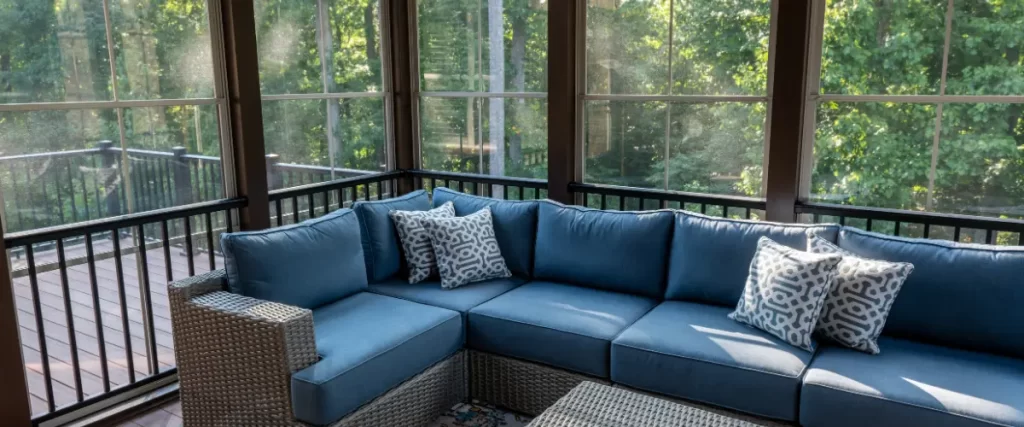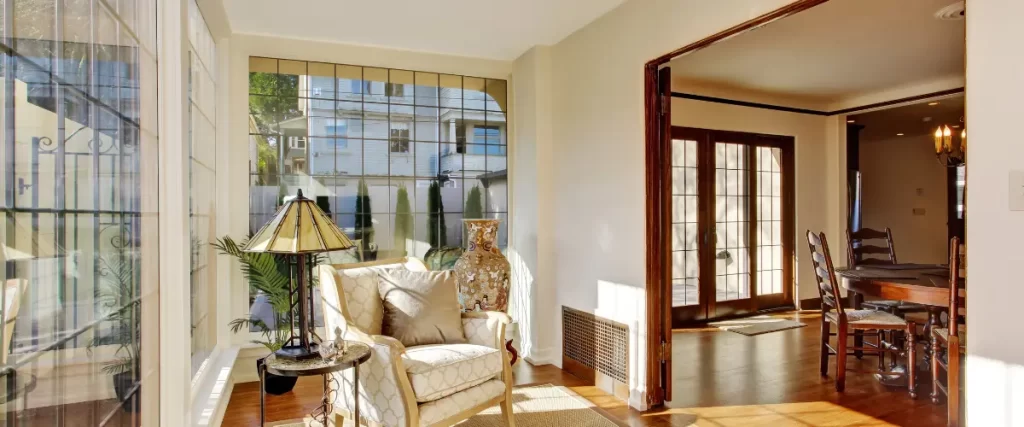Let’s face it—North Carolina weather can be all over the place. One week you’re battling 95-degree heat and humidity, and the next you’re sipping coffee on a chilly but sunny winter morning.
That’s why sunrooms have become such a smart investment for homeowners across the Tar Heel State. Whether you’re in Raleigh, Charlotte, Wilmington, or nestled in the Blue Ridge Mountains, a sunroom gives you that perfect blend of indoor comfort with outdoor vibes, without worrying about mosquitoes or sudden weather shifts.
But here’s the thing: not all sunrooms are created equal, and definitely not all are built with our unique climate in mind. So, if you’re thinking about adding a sunroom or upgrading the one you already have, let’s walk through the best sunroom designs that’ll keep you cool during those scorching summers and warm during our mild, sunny winters.

Why Sunrooms Work So Well in North Carolina
Sunrooms in North Carolina aren’t just a luxury—they’re practical. Our state has a humid subtropical climate, which basically means hot, sticky summers and mild winters with lots of sunshine. That combo makes sunrooms an ideal space for year-round enjoyment, if they’re built right.
Here’s what makes a well-designed sunroom thrive here:
Natural Light Access: With nearly 220 sunny days per year in places like Fayetteville and Raleigh, you’re not just building an extra room—you’re maximizing sunlight.
Energy Efficiency: Because we have long summers, sunrooms must be designed to minimize heat gain while still capturing light.
Mild Winters: North Carolina’s winters rarely dip below freezing, so a four-season sunroom can remain comfortable with minimal heating.
Outdoor Connection: From the Blue Ridge Parkway to the Outer Banks, we love our views—sunrooms offer that immersive experience without the bugs or pollen.
Types of Sunrooms to Consider for NC Homes
Not every sunroom fits every lifestyle, budget, or architectural style. Here’s a quick breakdown of the main types to help you decide what works best for your home.
1. Three-Season Sunrooms
Perfect for spring, summer, and fall. These usually aren’t insulated or connected to your HVAC system. You can add portable fans or heaters for more comfort.
This option is budget-friendly and perfect for enjoying warm weather. However, it can become uncomfortably hot during the peak of summer and too cold in the winter months.
2. Four-Season Sunrooms
Fully insulated, with HVAC connections. You can use this space every single day of the year—even during heatwaves or cold snaps.
A sunroom offers several advantages, including year-round usability and the potential to increase your home’s value. However, there are some drawbacks to consider. Sunrooms can be more expensive upfront and may require energy-efficient windows and materials to function effectively.
3. Solariums
These are essentially glass rooms—walls and roof. They’re stunning and bring in tons of light, but can get hot without proper glazing or shade systems.
This space offers amazing views and plenty of natural light, making it perfect for plant lovers. However, it does come with some drawbacks—such as the potential to overheat during the summer and the need for higher maintenance.
4. Screened-In Porches (Convertible to Sunrooms)
Already have a screened-in porch? Converting it to a sunroom can be a cost-effective way to gain extra square footage.
One of the benefits of this option is the lower cost, especially if you already have the necessary structure in place. Additionally, it offers the flexibility to be upgraded gradually over time. However, a potential drawback is that it may require structural reinforcement, which could add to the overall cost and complexity.

Design Features That Beat the North Carolina Heat
When you’re designing for North Carolina, you want to strike a balance: protect against that blazing summer sun while still capturing winter’s warmth. Here are a few must-have design elements.
Low-E Glass Windows
These windows reflect heat but let light in—perfect for hot summers. They also help retain warmth during cooler months.
Insulated Roof Panels
Don’t overlook the roof. Insulated panels can make a huge difference in comfort and energy efficiency.
Ceiling Fans
Simple but effective. Circulating air helps reduce dependence on AC and creates a more comfortable environment year-round.
Solar Shades or Blinds
For west-facing sunrooms especially, having retractable shades can block intense afternoon sun and protect your furnishings.
Thermal Flooring
Consider materials like tile or luxury vinyl that won’t warp with humidity and offer better thermal insulation.
Building Codes & Permits in North Carolina
North Carolina building codes vary by county, but here are some general things to keep in mind:
Permits are required for structural changes, electrical wiring, or HVAC modifications.
Zoning laws may restrict how close to your property line you can build.
If you’re in a historic district (like parts of Wilmington or Asheville), there may be additional architectural guidelines.
Check with your local building department or visit the NC Department of Insurance Building Code Office for specifics.
Location-Specific Design Ideas
Where you live in NC can influence your design choices. Here’s how:
In the Piedmont Region (Raleigh, Greensboro, Charlotte), it’s important to prioritize cooling features like ceiling fans, cross-ventilation, and UV coatings to combat the heat. Neutral colors can also help reflect heat effectively. For variable weather, consider adding transitional sunrooms that can adapt to changing conditions.
In Coastal Areas (Wilmington, Outer Banks), hurricane-rated windows are essential for storm protection. If you’re in a flood-prone area, elevating your sunroom is a smart choice. Additionally, using rust-resistant materials ensures durability in the salty, humid environment.
For the Mountains (Asheville, Boone), focus on maximizing insulation to stay warm during chilly evenings. Large south-facing windows are great for bringing in natural solar heat. Wood finishes are also an excellent option to blend your sunroom seamlessly with the natural surroundings.
Best Sunroom Manufacturers & Materials for North Carolina Homes
High-quality materials and trusted manufacturers make all the difference when it comes to long-term comfort and durability.
Top Manufacturers:
TEMO Sunrooms – Known for thermal roof systems and customizable designs perfect for all climates
Four Seasons Sunrooms – Offers energy-efficient solutions and great warranties
Patio Enclosures by Great Day Improvements – Strong focus on glass quality and sun protection
Sunspace Sunrooms – Canadian brand with solid insulation features; great for mountain areas
Champion Sunrooms – Known for combining sunroom design with solid window technology
How to Make Your Sunroom Truly Multi-Seasonal
Want to squeeze every ounce of value from your sunroom? Here are some extra ideas:
Adding radiant floor heating is a great way to keep your home warm and cozy during the winter months. Unlike traditional heating systems, radiant floor heating provides consistent warmth by heating the floors themselves, allowing the heat to rise evenly throughout the space.
This creates a comfortable and energy-efficient environment, eliminating cold spots and making those chilly mornings much more bearable. It’s an excellent upgrade for anyone looking to enhance comfort and efficiency in their home.
FAQs: Everything Homeowners Ask About Sunrooms in NC
How much does it cost to build a sunroom in North Carolina?
Prices range from $20,000 for a basic three-season room to $70,000+ for a custom four-season sunroom with HVAC.
Do sunrooms add value to my home?
Yes! Especially four-season sunrooms. They increase usable square footage and boost curb appeal.
Can I DIY a sunroom?
Possible, but tricky. NC’s permitting, electrical, and structural codes make it smart to hire licensed professionals.
Are sunrooms energy-efficient?
They can be. Use insulated glass, thermal walls, and proper ventilation to maximize efficiency.
What direction should a sunroom face?
South-facing is ideal for winter warmth. East-facing rooms offer soft morning light without overheating.

Ready to Build Your Dream Sunroom?
Designing a sunroom in North Carolina is all about balance. You want something that keeps you cool in July, cozy in January, and beautiful all year round. Whether you’re imagining a bright breakfast nook, a peaceful plant paradise, or a new space for hosting friends and family, the right design will make it happen.
And if you’re serious about getting started, don’t go it alone. Contact us at (919) 308-1515 and let’s talk through your sunroom addition project. We’ll help you create a space that feels just right—because every sunroom should be as unique as the home it belongs to.
